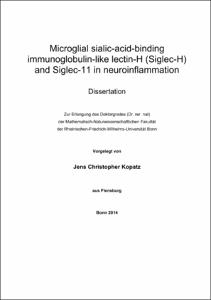Microglial sialic-acid-binding immunoglobulin-like lectin-H (Siglec-H) and Siglec-11 in neuroinflammation

Microglial sialic-acid-binding immunoglobulin-like lectin-H (Siglec-H) and Siglec-11 in neuroinflammation

| dc.contributor.advisor | Neumann, Harald | |
| dc.contributor.author | Kopatz, Jens Christopher | |
| dc.date.accessioned | 2020-04-20T19:13:25Z | |
| dc.date.available | 2020-04-20T19:13:25Z | |
| dc.date.issued | 16.01.2015 | |
| dc.identifier.uri | https://hdl.handle.net/20.500.11811/6398 | |
| dc.description.abstract | Sialic acid binding Siglecs are involved in various pathological processes. A minor fraction of Siglecs mediates activating signals via the ITAM linked DAP12 adaptor protein while the majority of Siglecs modulates inflammatory reactions via ITIM units. Siglec-11 and Siglec-H are both expressed on microglia cells but exhibit structural and functional differences. To get a better understanding about the function of Siglecs in microglia, one Siglec linked to ITAM and one linked to ITIM structures were studied. In cell culture experiments the ITAM associated murine Siglec-H receptor was upregulated after IFN-γ stimulation or IFN-γ/LPS co-stimulation in primary and cell line microglia. Microglial cells showed Siglec-H mediated engulfment of latex beads under pro-inflammatory conditions. Furthermore, a Siglec-H fc fusion protein bound to structures on two independent glioma cell lines while it did not bind control cells in in vitro experiments. Human Siglec-11 that exhibits an ITIM domain in its cytoplasmic tail is constitutively expressed on microglia and macrophages. The receptor was upregulated after pro- and anti-inflammatory stimulation. Via heat mediated hydrolysis and subsequent separation using a HPLC system, α2-8 linked sialic acid molecules with a length of around 20, 60 and 180 sialic acid chains were generated. Treatment with the different sizes of sialic acids revealed a chain length of around 20 sialic acids (PSA-20) to not cause harmful effects on the metabolic activity at concentrations of 0.15 μM, 0.5 µM and 1.5 μM. Post stimulation with PSA-20, a down-regulation of TNF-α transcription and phagocytosis activity was detected in microglia and macrophage cell lines. For in vivo experiments a Siglec-11 transgenic mouse line expressing Siglec-11 in the brain, spleen and liver was used. When the Siglec-11 mice were used in a model of chronic inflammation, PSA-20 mediated suppression of TNF-a transcription in the brain was successfully detected. The data reveal sophisticated functions of the two investigated Siglecs regarding recognition of disturbances and modulation of inflammatory reactions in the CNS. Therefore, the Siglec receptors represent interesting research targets that can increase understanding of the Siglec mediated defense against malignant cells and the modulation of inflammation in the CNS. | en |
| dc.language.iso | eng | |
| dc.rights | In Copyright | |
| dc.rights.uri | http://rightsstatements.org/vocab/InC/1.0/ | |
| dc.subject.ddc | 004 Informatik | |
| dc.subject.ddc | 570 Biowissenschaften, Biologie | |
| dc.subject.ddc | 610 Medizin, Gesundheit | |
| dc.title | Microglial sialic-acid-binding immunoglobulin-like lectin-H (Siglec-H) and Siglec-11 in neuroinflammation | |
| dc.type | Dissertation oder Habilitation | |
| dc.publisher.name | Universitäts- und Landesbibliothek Bonn | |
| dc.publisher.location | Bonn | |
| dc.rights.accessRights | openAccess | |
| dc.identifier.urn | https://nbn-resolving.org/urn:nbn:de:hbz:5n-38827 | |
| ulbbn.pubtype | Erstveröffentlichung | |
| ulbbnediss.affiliation.name | Rheinische Friedrich-Wilhelms-Universität Bonn | |
| ulbbnediss.affiliation.location | Bonn | |
| ulbbnediss.thesis.level | Dissertation | |
| ulbbnediss.dissID | 3882 | |
| ulbbnediss.date.accepted | 30.09.2014 | |
| ulbbnediss.institute | Medizinische Fakultät / Institute : Institut für Rekonstruktive Neurobiologie (IRN) | |
| ulbbnediss.fakultaet | Mathematisch-Naturwissenschaftliche Fakultät | |
| dc.contributor.coReferee | Schultze, Joachim L. |
Dateien zu dieser Ressource
Das Dokument erscheint in:
-
E-Dissertationen (4337)




